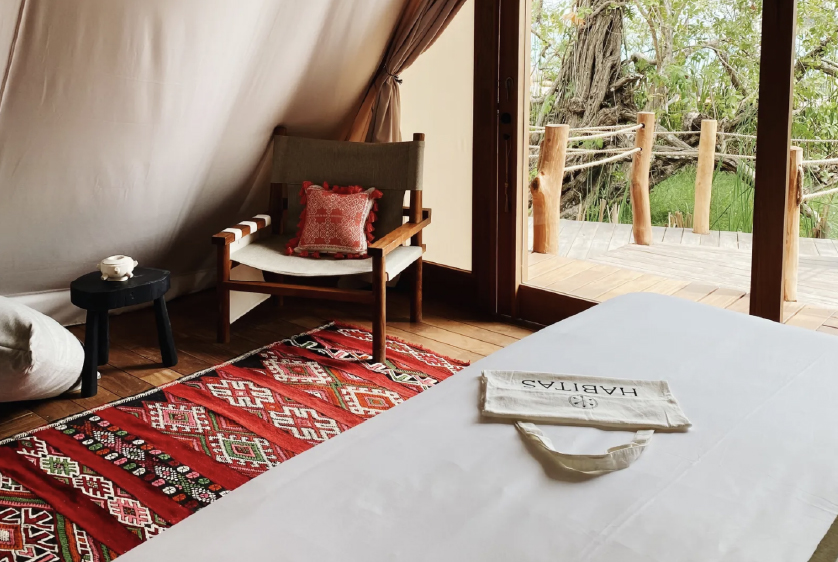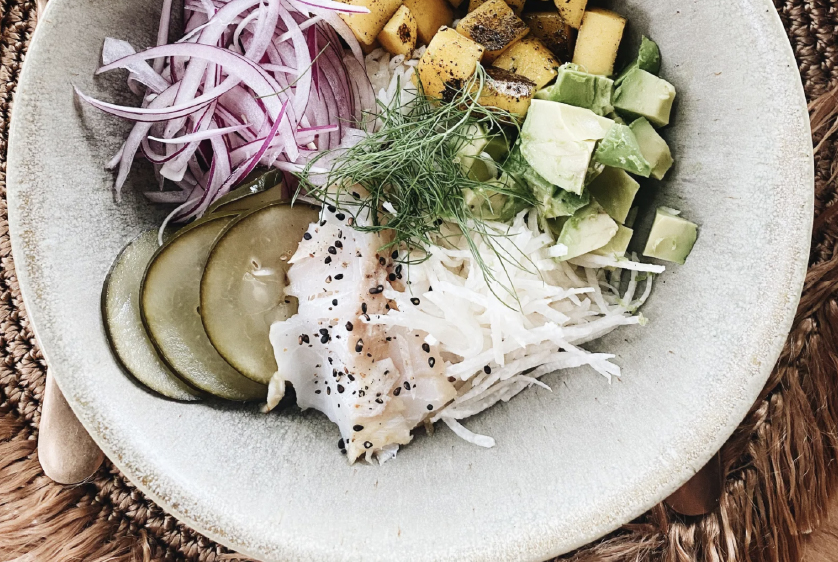
BY MICHAELA TRIMBLE – January 28, 2022
It’s pitch black outside when I draw the curtains from my A-frame suite at Habitas Bacalar. Stepping onto my teakwood deck, I use a flashlight to find my bearings as I walk down a pathway that leads to the lapping shores of the lagoon. When I arrive, I see the silhouette of Daniel Navarro, a guide from the local operator Adventure Lab. He’s waist-deep in the water, busy preparing our boards for a sunrise paddle session. I wade into the water to meet him. The steamy temperatures feel like I’m entering a bath, the chalky limestone sands like clouds at my feet. When I’m secure atop the board, I drift behind Navarro, making my way through the glassy waters. We’re careful to avoid the lagoon’s stromatolites; he tells me the rocky formations are estimated to be 3.5 billion years old and are actually living beings that, like coral, can die if we touch them. He also tells me that Bacalar’s original name derives from “Siyan Ka’an Bakjalal,” which roughly translates to a place surrounded by reeds where the sky is born. We’re already quite a way out from shore when I see why the Maya described the lagoon this way: a transformation from night to day begins as the sun shines its first golden strokes across the crystal-clear waters. From my board, I neither see nor hear any trace of development. The silence itself is a luxury, as are the Caribbean-like waters even though we’re miles from the coast.

Set in the Yucatán Peninsula’s most southern bounds near the southeastern border of Belize, Bacalar is stunning in its perfection. The tucked-away lagoon is a languid 26-mile-long body of freshwater; far from any major town, it feels a world away from it all—for now.
Lately, Bacalar has been receiving quite the buzz for many reasons, mainly for the tide of development the area is set to welcome in the coming years. Locals are concerned that with unbridled growth, Bacalar could turn into the next Tulum—overdeveloped and pillaged of its natural resources. But many newcomers who have recently set down roots in the area have come with the intention to be stewards of the land.


When I arrive back at the property in the afternoon, I head straight for the yoga platform to meet Amalia Moscoso, a transplant from Los Angeles who first moved to Tulum to further nourish her work as a healer. When I tell her I only have 15 minutes to spare, she smiles. Something about her calm nature appeals to me, so I ignore my to-do list and settle in for an afternoon breathwork and sound bath ceremony. By the end of the experience, nearly an hour has passed. I’ve gone from shaking to sobbing to having an overwhelming feeling of deep surrender. “There’s a clear energy of pure presence here,” she says after our session. “In my world, we call it zero-point energy. The water is so highly oxygenated, it’s like getting a baptism.”
Habitas Bacalar, which opened at the end of 2021, may be the most starry opening in the area, but there are other projects just as worthy of a visit. Many of them are set in the lagoon’s downtown pueblo, from restaurants like Nixtamal, a concept rooted in ancestral mixology and wood-fired cuisine, to the new Casa Hormiga. The 18-room boutique hotel, which opened in the fall of 2020, is where I stay for the rest of my trip. When I first arrive, I’m impressed by its grand Moroccan-style doors and its many open-air communal spaces, including a series of intimate outdoor pools and a palapa-style library, where coffee table books on astrology sit next to literature dedicated to Mexican architecture.

In the evening, the rains come. I find the conditions especially fitting for my afternoon spa appointment. Rooted in the elements, each treatment is around three hours long. I’m greeted by a team of therapists who offer me a copal cleansing followed by a cacao ceremony. I then change into my bathing suit for a janzu water-based meditation. I’m already thoroughly relaxed by the time I settle in for my massage. But the real prize of the experience awaits when I wake up from my treatment to see candles lit around a copper soaking tub made fragrant with twigs of rosemary and grapefruit slices.
On my last night in town, Moscoso invites me for dinner at her favorite restaurant, Macario, helmed by chef Ricardo Méndez, who formerly studied under chef Enrique Olvera at Pujol in Mexico City. We’re joined by Oscar Luna, the owner of local mezcaleria Damajuana and sushi bar Naō, and a group of his friends, visitors from Canada and Europe. Gathered around a wooden picnic-style table, we share a trio of cured small plates crafted by Méndez: a buttery red snapper in housemade yuzu, a fresh ceviche topped with smoked mayonnaise and totomoxtle (dried corn leaves), and cactus brined in vinegar of xoconostle (sour-prickly pear).
While we eat, Méndez tells us that he moved to Bacalar to open his restaurant about two years ago to escape the noise of Tulum and Mexico City. Not only does he enjoy the lifestyle Bacalar affords him, he also finds joy in working with the local ingredients available in and around Bacalar. He sources almost everything for his restaurant from nearby villages. One of his favorite ingredients to work with, he tells me, is the fruit black sapote; its mild, nutty flavor and creamy texture makes for delicious desserts.
Méndez’s next projects include building the restaurant’s own farm and establishing a waste-management program. “It’s my way of giving back to Bacalar,” he says. “It also sets an example of how a restaurant can take care of the environment.”
For now, the widespread concern around Bacalar’s development seems to be working in its favor. New projects are factoring in the ecosystem’s fragility, with developers doing what they can to preserve the landscape. One such project is the 22-casita Boca de Agua—a conscious development by the entrepreneur Rodrigo Juárez that’s designed by the famed Mexican architect Frida Escobedo—which is set to open in 2023 within an 82-acre natural reserve and reforestation area. The hotel will be built from sapodilla wood certified by the Forest Stewardship Council and will be on stilts so as to preserve the mangroves. And if my dinner table company is any indication as to the direction of Bacalar’s growth, the destination seems to be in good hands.
Source: https://www.vogue.com/article/bacalar-mexico-yucatan-peninsula-guide
